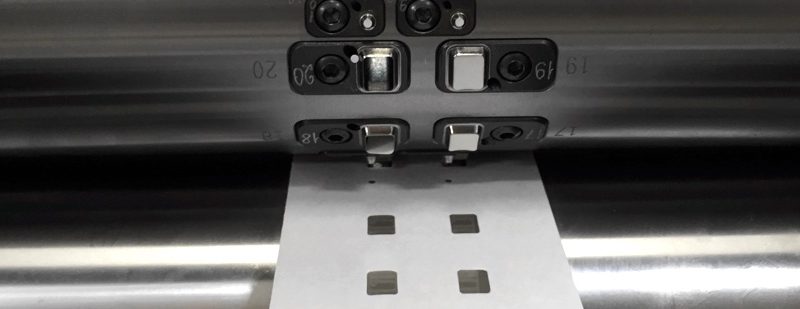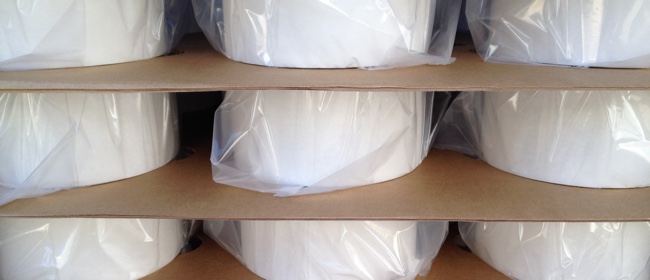There’s no doubt that the advent of the dot matrix printer was a game-changer in the office space. Sure they were slow, and the pin feed holes could be a hassle, but for the first time, companies could easily customize the contents of a small batch of labels on their own schedule. The office has benefitted ever since.
Now as lean manufacturing has become a more prevalent practice, there has been a demand to replicate this just-in-time (JIT) label solution onto the factory floor. But while blank white paper labels work in the front office, there are many cases where you might need a more robust solution than you could pick up at the office supply store. Those reasons might include:
- Durability requirements beyond a paper label
- Needs for a non-standard size
- Necessity for performance adhesive
- UL label requirements
If you are looking to design custom labels to be part of a JIT label solution, consider the following to maximize the effectiveness of your project:
1 The Printer Matters
The first question to consider is what type of process will you be using to print at your facility? Each has different pros and cons—so it depends on your intended application. Of note, if you are looking to purchase a machine in addition to labels (instead of utilizing existing equipment), looking at the printer, application, and material holistically is often the best solution. For reference, common just-in-time options include:
- Direct thermal
- Thermal Transfer
- Ink Jet
- Dot Matrix
- Laser Toner
Now, these different printing processes require different label materials to function optimally. Basically, you need to match your ink system to a compatible label material. Thus understanding which printer type you will be using at your facility will help guide material selection, and improve print performance.
Often overlooked, but equally important, are the physical specifications of your machine. If the custom labels don’t fit in your printer, you have a problem. Questions to ask yourself include:
- What is the maximum width of labels that can run through the printer? • Does the machine need cores, sheets, or fan-folded labels? • What core sizes does the machine accept?
- Is there a maximum outside diameter for a roll of material?
2 Don’t Settle for the Standard Material
Label substrates perform differently depending on the situation. Just because a label company has a “standard” JIT material that they always use, doesn’t mean it is right for you and your application. The material (and adhesive) you print your labels on matters greatly. And since you are already customizing the product to fit your system, make sure you consider all of your performance requirements.
As discussed in section [1], we already know that you need a substrate that fits your printing process. Just as important is that it also fits your application. Questions to consider include:
- To what surface are you sticking the label: flexible, rigid, smooth, rough, flat, convex, etc?
- Are there high/low application and/or service temperature concerns? • How durable does the label need to be?
- Do you need something that is very sticky right away (high initial tack) or would an adhesive with some early repositionability (low initial tack) be better suited?
- Will this be an outdoor or indoor label?
Equally important: be sure to ask for samples to test how the material functions. In the end, performance is in the eye of the beholder. So make sure you find a material that performs to your expectations when printed by the machine you will be using.
3 Make Shapes and Sizes Work For You
The whole point of moving towards a just-in-time custom solution is control and efficiency. Don’t lose track of that during the design process and stick with a rectangle shape needlessly.
Evaluate how your label is being used. Would a slightly irregular shape fit the application area better? Would a peel tab aid in the application? Would an extra, perforated section help with quality assurance?
You might be surprised to find, that customizing the size and shape of the label can greatly impact usability and actually cost less in many cases.
4 You Don’t Have to Print it All
Don’t confuse a custom JIT label solution with a blank label. Just because you are printing some of the information, doesn’t mean you have to print all of it at the point of use.
Depending on your chosen process, having your label manufacturer print static information ahead of time can save on printing consumables. Just as important, it can also create a more professional overall appearance. For example, company logos or address footers are no longer limited to one color. Images are now free to incorporate more complex elements such as screens and shading.
Analyze your labels to determine which elements are variable, and which ones will remain constant from version to version.
5 Consider Kits
Do you have a process that involves multiple labels? Consider utilizing custom-designed kits. Nesting labels is one of the easiest ways to make your JIT process just that much more efficient.
Consider the example below. Rather than setting each label up individually and running them all separately through the on-site printer, they are combined onto one perforated segment. Now all the data—everything—is printed in one efficient pass.
Here are some additional benefits of kits:
- Poka-yoke (ポカヨケ) – Japanese lean manufacturing term for mistake-proofing the manufacturing process
o If any label is still on
Label #1 Part Number & Application Instructions
Label #2
the sheet, a labeling
opportunity has been missed
o Relevant instructions can be included on the label sheet
- The simultaneous printing of all the labels has multiple advantages o Unparalleled color uniformity between labels
o Material consistency
o Same adhesive freshness for all labels applied to a finished assembly
- Inventory management is simplified (issue one roll/sheet of labels in your bill of materials instead of seven)
Conclusion
In the end, if you are going to create a lean, just-in-time labeling solution to fit your process, consider these 5 tips to truly customize it for your needs.
By getting together with your label manufacturer to design a complete solution, you end up with a result that is a more professional, efficient, and a better product all the way around.


